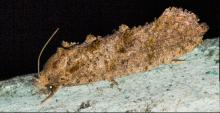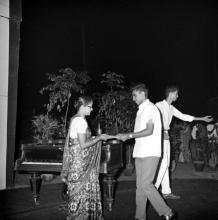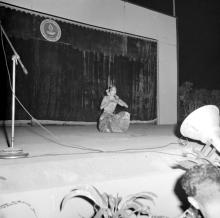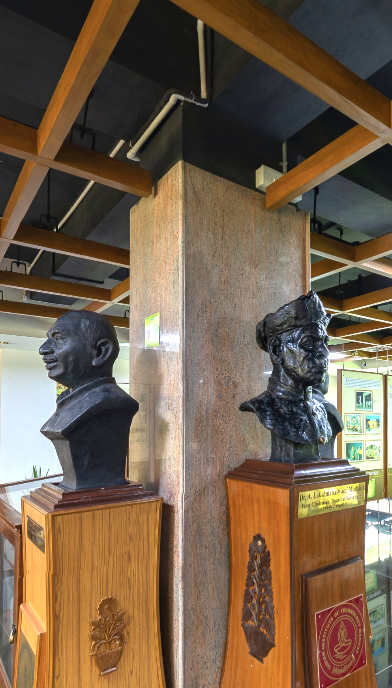Sesame leafroller moth [Antigastra catalaunalis]
![Sesame leafroller moth [Antigastra catalaunalis]](/sites/default/files/styles/medium/public/photographs/0045_16.jpg?itok=blK760oN)
- Photographs
According to Wikipedia, this moth “is endemic to tropical and subtropical areas (South Asia, Malay Archipelago, Africa), but is also found in other areas due to its migratory nature.” The wingspan is recorded at 19-22 mm. According to RGV Bug Blog, “As their name suggests, they web the top leaves and terminal portion of the plant to provide a protected location where they will feed.” In other words, the moth weaves together the leaves in order to protect itself.
Algira passenger moth [Dysgonia algira]
![Algira passenger moth [Dysgonia algira]](/sites/default/files/styles/medium/public/photographs/0038_17.jpg?itok=tFYuDuDt)
- Photographs , Flora & Fauna
The head and body of the Algira passenger moth are dark brown. The front wings are large and almost straight edged with a light grey band with silver accents. The hind wings are also dark brown, with a band in the middle. The wingspan is approximately 38-44 mm.
This moth is either Chiasmia nora or Chiasmia eleonora [identification required]
![This moth is either Chiasmia nora or Chiasmia eleonora [identification required]](/sites/default/files/styles/medium/public/photographs/0046_11.jpg?itok=OhKBHCof)
- Photographs
The two species Chiasmia nora and Chiasmia eleonora are similar in size and appearance. According to Wikipedia, the wingspan is around 42 mm for both the species. Larvae of both species are known to be reared on Acacia species.
Rice caseworm [Parapoynx stagnalis]
![Rice caseworm [Parapoynx stagnalis]](/sites/default/files/styles/medium/public/photographs/0034_24.jpg?itok=6b-J70O6)
- Photographs , Flora & Fauna
The larvae of the rice caseworm are around 15 mm long according to TNAU Agritech Portal. The pupa is cream in colour and measures around 5.5 mm in length. The mature pupa is silvery white. The adult “Moth is small, delicate white with pale brown wavy markings. The adult moth is about 5 mm long. It is bright white with light brown and black spots.” The larvae, according to Wikipedia, consume the leaf blade until only the midrib is visible. According to Wikipedia, “Eggs of rice caseworm can be controlled by using snails. Larvae can be controlled by using many natural predators like water…
Noctuid moth, Family- Notodontidae (this moth belongs to the superfamily Noctuoidea)

- Photographs , Flora & Fauna
Notodontidae is a family of moths with over 3800 known species. According to Wikipedia, “species of this family tend to be heavy-bodied and long-winged, the wings held folded across the back of the body at rest. They rarely display any bright colours, usually being mainly grey or brown.” They are known to resemble members of the family Noctuidae, although they are not closely related.
A moth of the genus Scopula [confirmation required]
![A moth of the genus Scopula [confirmation required]](/sites/default/files/styles/medium/public/photographs/0039_17.jpg?itok=Vt2-ipMY)
- Photographs
The moth belongs to the Geometridae family, and was “described by Franz von Paula Schrank in 1802.” (Wikipedia). According to the Moths of India website, 78 Scopula species are found in India: “Scopula is a cryptic genus with many species lacking a distinctive fascia on the wings. Hence, genitalia and/or barcoding are needed to separate species with certainty.” A fascia is a colour pattern with a broad band on the wings.
Plain grey hawkmoth [Psilogramma increta]
![Plain grey hawkmoth [Psilogramma increta]](/sites/default/files/styles/medium/public/photographs/0043_16.jpg?itok=aGdPrD1I)
- Photographs , Flora & Fauna
The moth belongs to the Sphingidae family, also known as sphinx moths. According to Wikipedia, they are moderate to large in size, with a wingspan of 90-122 mm. Some hawk moths are mistaken for hummingbirds owing to their habit of hovering in mid-air while feeding on nectar from flowers. According to the website tpittaway.tripod.com, “Males can make a weak hissing sound by rubbing scales over spines at the end of the abdomen.” It also describes the larva “Full-fed 69--110mm. Pale yellow on hatching, with a large black horn. With feeding the body colour becomes more green. At this stage most…
Citrus fruit piercer- female [Eudocima phalonia]
![Citrus fruit piercer- female [Eudocima phalonia]](/sites/default/files/styles/medium/public/photographs/0040_16.jpg?itok=BGsqoO9-)
- Photographs , Flora & Fauna
The female moth, according to Wikipedia has a wingspan of about 90-110 mm, while that of the male is 80-94 mm. The body is approximately 5 cm long. According to the Pestnet website, “The moth has a feeding tube (proboscis) that is up to 25 mm long, barbed and strong enough to penetrate tough rind of fruits and to suck out the juices.” The holes that Citrus fruit piercers make in fruits provide entry points for bacteria and fungi. According to the Pestnet website, “The caterpillars are dark brown to black when together in large numbers, and pale yellow to green when solitary. The pupae develop…
The geometrician [Grammodes stolida]
![The geometrician [Grammodes stolida]](/sites/default/files/styles/medium/public/photographs/0042_16.jpg?itok=53oNUyZR)
- Photographs , Flora & Fauna
The geometrician belongs to the family Erebidae. The wingspan of the adult is 40-44 mm according to the ukmoths website. According to the iNaturalist website, “It is found in Africa, southern Europe, most of Asia and Australia. It migrates to central and northern Europe as far north as England, Denmark and Finland.”
Crimson underwing, Erebidae family [confirmation required]
![Crimson underwing, Erebidae family [confirmation required]](/sites/default/files/styles/medium/public/photographs/0035_20.jpg?itok=wczzGlmf)
- Photographs , Flora & Fauna
The Erebidae family of moths falls under the superfamily Noctuoidea. According to Wikipedia, it is among the largest families of moths. The family includes underwings, litter moths, tiger moths, lichen moths, and wasp moths, and many others. The largest moths can have a 127 mm wingspan (in the black witch), while the smallest have 6 mm wingspan (Micronoctua karsholti). Erebid moths come in all colours, from drab and dull to vivid and colourful. According to Wikipedia, moths from the family are found in all continents except Antarctica.
Acacia blood vein moth [Traminda mundissima]
![Acacia blood vein moth [Traminda mundissima]](/sites/default/files/styles/medium/public/photographs/0037_17.jpg?itok=4nuz9nBf)
- Photographs , Flora & Fauna
The name ‘blood vein’ stems from the fact that the adult moth has a unique reddish line that runs across its wings. Pritha Dey, a moth-biologist and post-doctoral researcher from the Indian Institute of Science, Bangalore, describes it as “a leaf mimicking moth”. According to Wikipedia, “Adults are brown or green, usually with a dark edged yellow arc across the forewing. The hindwings have an angular tornus.” The tornus is the bottom corner of an insect’s wing.
Parasa tea moth [Parasa lepida]
![Parasa tea moth [Parasa lepida]](/sites/default/files/styles/medium/public/photographs/0044_16.jpg?itok=bnwyh39G)
- Photographs , Flora & Fauna
According to Wikipedia, Parasa lepida is a moth of the family Limacodidae. The moth is mostly green with brown and reddish brown colours. The larva is pale-green, whitish or bright yellowish green on the dorsal side. The cocoon is purple brown. (Source: Wikipedia). Interestingly, the caterpillars have nettles which contain a substance that can irritate human skin if touched. They are known as tea moths owing to the fact that the larvae are often found in plantations with commercial crops such as tea and coffee.
A student receiving a prize from Mrs. Sushila Ramachandran (Director’s wife) at the annual Literary and Cultural Week

- Photographs , Cultural Events, Dramatics, Institute Events , 1960s
The most looked forward to event at IIT Madras in the 60s was the annual Literary and Cultural Week. The first Literary and Cultural Week was held in 1964. At the event the students competed for a number of prizes and trophies. The following are some of the trophies awarded to the winners: The Dr. N. Klein’s Trophy was the trophy given to the winner of the Inter-Collegiate German Recitation competition. The trophy was named after Dr. Nikolaus Klein who was a professor of German at IIT Madras. The Dr. M. V. C. Sastry’s rolling trophy was awarded to the winner of the Inter-Collegiate Group…
A student performing a dance recital as part of the Entertainment Competition at the annual Literary and Cultural Week

- Photographs , Cultural Events, Dramatics, Institute Events , 1960s
Seen in the image is a student performing what appears to be a Bharatanatyam solo at the Open Air Theatre. The most looked forward to event at IIT Madras in the 60s was the annual Literary and Cultural Week. The first Literary and Cultural Week was held in 1964. Literary and Cultural Week became a very big part of the IITian culture and still is to this day under a different name, ‘Saarang’.The most popular competition of the event was the Inter-collegiate Entertainment Competition. This competition was conducted at the Institute’s Open Air Theatre and consisted of students showcasing…
Students participating in an event that is probably Group Discussion at the annual Literary and Cultural Week

- Photographs , Institute Events, Student Activities , 1960s
The most looked forward to event at IIT Madras in the 60s was the annual Literary and Cultural Week. The first Literary and Cultural Week was held in 1964. Literary and Cultural Week became a very big part of the IITian culture and still is to this day under a different name, ‘Saarang’. The main events that took place at the Literary and Cultural Week were the quiz, German recitation, debate, group discussion and the entertainment competition. There were other events taking place as well such as the science fair, photography exhibition and art competition. Some of the trophies given to the…
- Contribute
to the Centre -
Monetary
Support - Digital
Material









